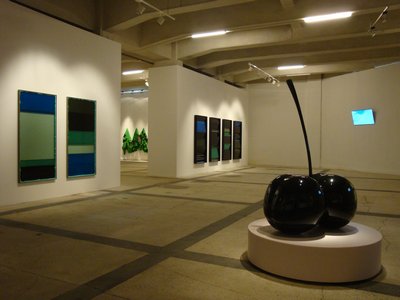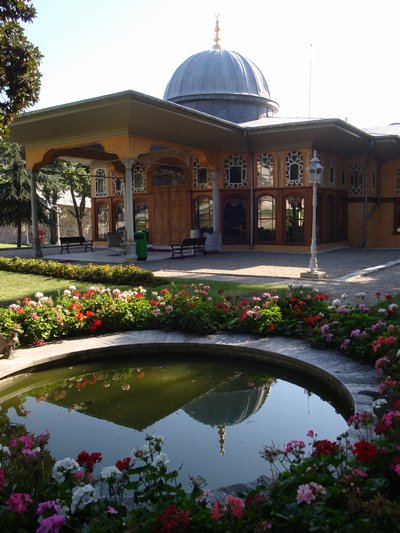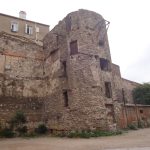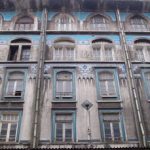It being another lovely sunny day, I thought I’d take the ferry up the Golden Horn to Hasköy and check to see whether the Aynalıkavak Kasrı pavilion really had reopened to the public as was rumoured. It’s always lovely to take that ferry ride although I was a disappointed to find the Fener pier closed for renovation before the Balat one has reopened. Given the narrowness of the shore road to Fener and Balat you’d think it would be a high priority to keep the alternatives going.
Whatever. From the ferry I noticed that restoration had started on the cast-iron church of St Stephen of the Bulgars while work on the Bahriye Nezareti (Naval Command Office) at Kasımpaşa is still ongoing although so far behind schedule that the the planned completion date has been scratched out on the sign. Stepping ashore at Hasköy was a relief after the madness that is Sultanahmet in September. OK, so the pavements are so narrow that two people can’t pass each other without one having to throw themself in front of the traffic but at least you escape being bothered by multilingual touts pushing everything from carpets to toy cats with an irritating mechanical meow.
It’s two years since I was in Hasköy and it was interesting to spot mild signs of Tophane-style art-led gentrification in the shape of the new Galerist in what was once a local yarn factory. Once I’d got over the shock of crossing the threshold to be confronted with a sign reading “That’s Fucking Awesome” and fumbled my way through a blackened entrance draped with what felt like giant strips of flypaper it was to come face to face with a outsize screen on which sweet wrappers appeared to be blowing in the wind. Hmmm. Not too sure what that was all about, nor yet what to make of the “She’s Awfully Beautiful” and “He’s Disgustingly Handsome” statements quite literally nailed into the walls. The machine-made grey carpets studded with golden hobnails that looked from a distance like glorious gates – I could quite go for those though.
The thing about gentrification is how abrupt and jarring it seems in the early stages. No sooner had I stepped blinking into the light again than I was stumbling into a tiny tea garden beside what looked like a Byzantine brick building which the usual relentlessly male posse of çay drinkers told me had once been a small courthouse. Just up the road the gate leading into the Church of St Paraskevi was standing open. Inside a woman was tending the small graveyard. “Are you Christian?” she asked which should have been an easy question but wasn’t. Am I Christian? Of course I’m not in any religious sense of the word although in a cultural sense I suppose I am by the sheer fluke of having been born in the UK. Anyway, a white lie that would act as an open sesame to the church seemed a small price to pay for the chance to see inside it and soon I was gazing in awe at the glittering iconostasis on which the images of the saints were all but lost amid the bling.
“So much gold,” I murmured in what I hoped was a suitably deferential and grateful tone.
“Of course not gold,” the woman retorted sharply. “Just paint,” and I understood completely having had my fill on recent travels in the east of being told that damage to historic buildings had been caused by people digging into everything in search of supposedly buried gold.
In the caretaker’s office by the gate sat Istavro, a plump elderly man who had Greek taverna music playing on his ghettoblaster and who made a sign of the cross to indicate the meaning of his name to me. The shelves beside him were lined with black and white photographs of venerable-looking priests, all long black robes, long grey beards and stern, unbending faces. I studied one taken in 1968 that showed women and children crowding around their priest. The girls wore skirts that rode high above their knees, their mothers were dead ringers for Jacky Onassis. “All gone,” Istavro told me as the bouzouki trilled on in the background.
But Hasköy was once as much a Jewish enclave as a Christian one. According to Istavro, the ruined brick building uphill from the church was the burnt-out remains of the Rum school (“We’ll rebuild it in concrete. The rent will be amazing,” he said – a reference presumably to recent news that the property of the minority communities is to be returned to them) while the brick building right next door with a lock on its gate had been a synagogue. Just up the road the Safiye Sultan cafe is also housed in an old synagogue that was converted to new use in 2001.
Over by the water I found the countryside making itself at home on the lawn where someone had installed a flock of ducks. Meanwhile on the pavement a lone white Wallace and Gromit cockerel with a fop-like crest so floppy it was getting in his eyes was guarding a precious few inches of pavement with not a hen in sight, poor thing. Between here and Aynalıkavak Kasrı virtually all the land beside the water is owned by the military and the pavement is never wide enough to walk on comfortably. But just as I was starting to wonder why I’d bothered I rounded a corner and – yes! – the gate was finally open and I was ambling into what had once been one of Sultan Ahmed III’s pleasure gardens.
Aynalıkavak Kasrı had been closed for restoration for so many years that the notice advertising this fact had itself become in need of restoration but the wait turned out to have been well worth it because not onyl is the pavilion a real little beauty but the gardens around it are lovely, full of mature trees and hydrangea bushes. When the magnolias are in bloom it will be nothing short of perfect.
There was the usual mild frustration of having to be shown round by a guide which always prevents you from spending the time you really want to on looking at things properly. A TV crew was also ensconced there, shushing the guide and annoying the hell out of me. Admission was only TL2, a snip to spend an hour amid such beauty.
I lingered longer than I’d meant to in the gardens, wishing that the buildings in front of the pavilion could have been taken down so that it would once again have an unimpeded view of the Golden Horn but otherwise just astounded to find such a peaceful place amid such busyness. Outside the gates, I was immediately back to flattening myself against the wall every time someone wanted to pass and was sorely tempted to hop into one of the dolmuşes to Şişhane that kept rushing past. Astonishingly the new hop-on, hop-off bus service from Sultanahmet actually plies this road, adding to the chaos.
Close to Kasımpaşa a walkway has been cut into the hillside. It makes a great lookout point, with the Istanbul skyline unspooling in front of you like a film. At Kasımpaşa I paused just long enough to inspect the statue of Cezayirli Gazi Hasan Paşa with the lion with which he would apparently stroll round the shipyards. Signs beside the Bahriye Nezareti forebade me to photograph it even in its semi-restored state. Ah well, there was a ferry to Eminönü waiting and I was done for the day.
Written: 23 September 2011



